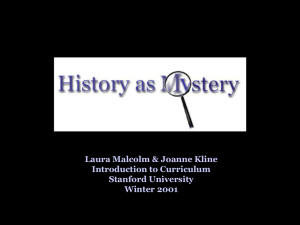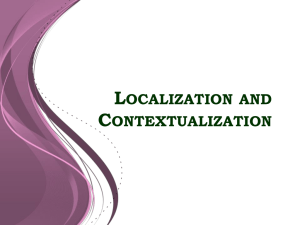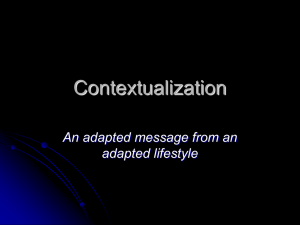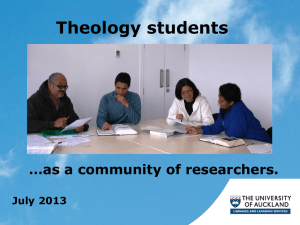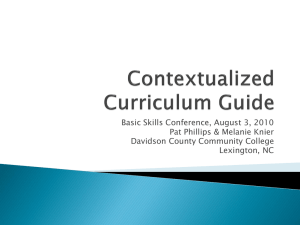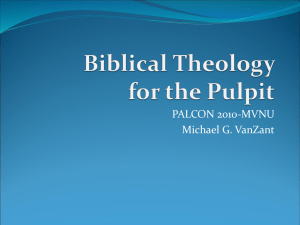Contextualization
advertisement
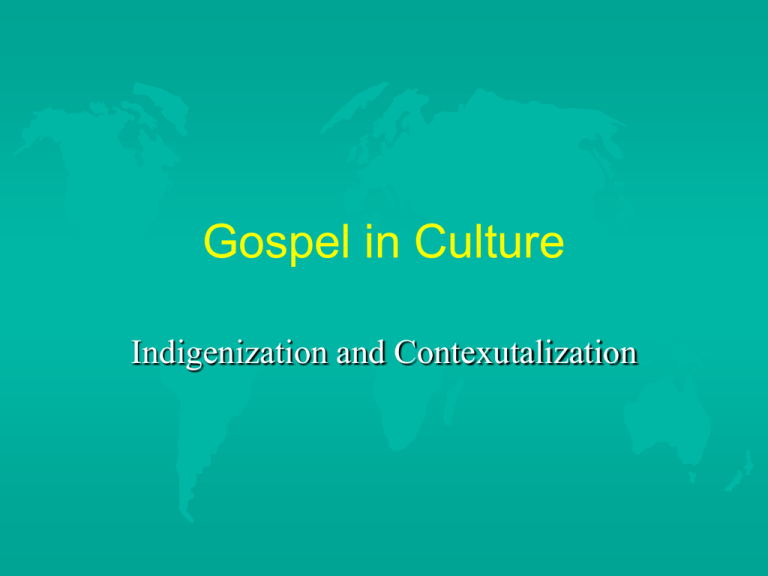
Gospel in Culture Indigenization and Contexutalization Gospel in Culture Etic analysis of culture In anthropology the “etic” model, or construct, is the means of describing people and cultural phenomenon from “the analyst’s conceptual categories and basic assumptions” rather than from the categories and assumptions of the people with whom the anthropologist interacts (Hiebert 1983, 50). Gospel in Culture Emic analysis of culture The emic model which describes people and their cultural phenomenon from their perspective using their conceptual categories and words. Gospel in Culture Ethnography Methodology that looks for significant patterns of behavior in social contexts and seeks to interpret them according to the insiders perspective. Studying a way of life Gospel in Culture Five Missiological Implications of Ethnographic Research Missionaries need to be competent in ethnographic research Ethnographies are helpful in mission preparation Crucial in ongoing contextualization and problem of nominalism Used to provide comparative data to help with strategies Should be use by mission leaders to better understand internationalization and globalization Four Models Missions Replication Indigenous (~1861) Contextualization (1971) Self-Theologizing (Hiebert, 1985) Four Models Missions Replication Replication – A strictly etic model would coincide with Shenk’s “replication model” or the “structural model” in Lamin Sanneh’s words (Sanneh 1999, 66). Shenk describes the “replication model” as one that “seeks to replicate or reproduce a church in another culture patterned carefully after that of the church from which the missionary originated.” The missionary retains control and responsibility for the church (1999, 51). The missionary also becomes the final authority for theological reflection, application, and defining theological and cultural constructs. Four Models Missions Replication Model Meaning: Scripture: Exegesis/interpretation/application Form Meaning Missionaries Culture Gospel Transmission Cultural Grid Host Culture Four Models Missions Indigenization Indigenization – the translatability of the Christian faith into the forms and symbols of the particular cultures throughout the world. In other words, make the gospel intelligible and relevant in word and deed to the eyes and ears of the people being taught. Rufus Anderson is considered the founder of the “indigenous church principle” (Beaver 1967, 31). At the core of the indigenous model is Anderson’s concept of the “three-selfs” which is also associated with Henry Venn and John Nevius. Four Models Missions Indigenization John Nevius and Henry Venn Three-selfs (1) Self-governing (2) Self-propagating (3) Self-supporting Four Models Missions Indigenization Positive contributions (1) Churches were not as financially dependent on missionaries (2) In reacting to the “Old System” where “native churches” depend on foreign funds to support and stimulate growth, John Nevius places emphasis on “applying principles of independence and self-reliance” from the initiation of the new churches (1958, 8). (3) Provided a model for missionaries to assist in maturing independent churches. (4) Moved away from a total replication model. Four Models Missions Indigenization Limitations and problems (1) Control still in hands of missionary or mission “This opening for paternalism is provided by giving the missionary responsibility to decide when a church is to be organized, to determine how it shall be organized…” (Beaver 1967, 34) (2) Leadership controlled by missionary The reduction of dependence on the mission funds did not reflect an equal independence from the control of the missionary. “The leader constantly superintends, directs, and examines those under him; the helper directs and examines the leaders and their stations; and the missionary in charge has a general supervision and control of the whole” (Allen 1958, 32-33). (3) Focus mainly on structural aspects and finances Four Models Missions Indigenization Indigenous church concept (1) Associated with Sidney J. W. Clark (2) Clark published a pamphlet entitled “The Country Church and Indigenous Christianity”, later published and given worldwide circulation through the World Dominion Press under the tile of “The Indigenous Church.” (3) By 1924 a movement was founded under the name of “World Dominion” to propagate the “indigenous church” theory. Four Models Missions Indigenization Indigenous church concept (4) Two primary principles were added to the “three-selfs”. First, “the foreign missionary should devote himself to pioneer evangelism” and not take on “pastoral duties for a congregation”. Second, “nothing should be instituted on the mission field by the mission which could not be taken over, maintained, and conducted by the native church” (Ritchie 1946, 13-18). Four Models Missions Indigenous Model Form Meaning Form of Christianity to fit in cultural context Four Models Missions Contextualization Origin of concept: The term “contextualization” came upon the missiological scene in 1972 with the publication of the Theological Education Fund’s (TEF) Ministry in Context: The Third Mandate. TEF observes that contextualization conveys “all that is implied in the familiar term ‘indigenization’ and yet seeks to press beyond for a more dynamic concept which is open to change and which is future-oriented” (Coe 1976, 21). Four Models Missions Contextualization Definition: Stephen Bevans defines contextual theology as “a way of doing theology in which one takes into account: the spirit and message of the gospel; the tradition of the Christian people; the culture in which one is theologizing; and social change in that culture, whether brought about by western technological process or the grass-roots struggle for equality, justice and liberation” (1992, 1). Four Models Missions Contextualization Definition: Victor Cole defines contextualization as “a theological formulation from exegesis of biblical texts within a socio-cultural context, and a living out of that theology within the given cultural context, utilizing the Bible as the only authority while recognizing the progress of biblical revelation” (1998, 12). Four Models Missions Contextualization Four arenas of contextualization according to the Theological Education Fund’s Report. •Missiological – focus on renewal & reform issues for human development and justice •Structural – develop structures socio-economic and political contexts •Pedagogical – training in servant ministry, not elitism and authoritarianism •Theological – finding appropriate ways of doing theology in various contexts related to ministry issues within and without the ministry contexts Lienemann-Perrin 1981, 175 Four Models Missions Contextualization Fourth self – moving beyond indigenization Self-theologizing – Christians and church leaders do their own theology through studying scripture and make application to their own cultural situation. Four Models Missions Contextualization Model Form Meaning Four Models Missions Emic-Contextualization (a) “Emic contextualization” is intended to convey the idea that the host culture Christians are taking the leading role in contextualizing the gospel message in their cultural context by increasingly providing the theological categories for doing theology. (b) Emic-contextualization progresses from a relatively unconscious self-contextualization to a conscious grappling with the application of biblical teaching to the cultural context. (c) Thus for an African context, there would be particular African Christian theologies emerging from their own contexts which address their daily concerns. Four Models Missions Emic-Contextualization Model Form Meaning Facilitating Emic-theologizing The six dimensions for evaluating emic-theologizing: • • • • • • Cognitive Affective Evaluative Missiological Structural Ministerial Facilitating Emic-theologizing Cognitive - The “cognitive” dimension refers to “knowledge,” but specifically, the ability to conceptualize biblical knowledge from the educational process, from personal study, and from experience to make application in various cultural contexts. Affective - The “affective” dimension involves the feelings the ministers have toward their theological education experience both positive and negative. Evaluative - “Evaluative” refers to the ability to interact with one’s own cultural heritage, current socio-cultural context, and the church context to apply the biblical message to make decisions in determining right and wrong within a ministry context Facilitating Emic-theologizing Missiological - The “missiological” dimension focuses on developing training that addresses renewal and reform issues in the church dealing with human development and justice in its particular context. Structural - The “structural” category refers to the administrative and infrastructure of the church and its various institutions for carrying on ministry and providing training sensitive to the socio-economic and political contexts. Ministerial - The “ministerial” dimension carries the idea that the ministers and other church leaders see themselves as developing in their ministry skills and personally experiencing a dynamic relationship with God in their churches and communities. Critical Contextualization The Process • Exegesis of culture • Exegesis of scripture & hermeneutical bridge • Critical response • New contextualized practices Critical Contextualization Exegesis of Culture “The first step calls for a phenomenological analysis of the culture. This involves studying the culture to understand “the categories, assumptions and logic the people use to construct their world.” Critical Contextualization Exegesis of Scripture & Hermeneutical Bridge In the second step, there is a need for an “ontological critique” that tests “the truth claims of different beliefs and values.” The two criteria for testing truth are: (1) Scripture (2) “Reality testing” to avoid an ethnocentric understanding of reality. “Reality testing” calls for an examination of one’s own understanding of reality and that of the host culture. Critical Contextualization Critical Response The third step calls for an “evaluative response” which means one critically evaluates his/her own beliefs, customs, and cultural norms in light of the improved understanding of the other culture and one’s own previous biblical understanding and cultural assumptions. Critical Contextualization New Contextualized Practices The fourth step envisions “transformative ministries” that assist people to “move from where they are to where God wants them to be” (1994, 88-90; 1999, 21-29). Critical Contextualization Theology Millard J. Erickson defines theology as “that discipline which strives to give a coherent statement of the doctrines of the Christian faith, based primarily upon Scripture, placed within the context of culture in general, worded in a contemporary idiom, and related to issues of life” (1985, 21). Critical Contextualization Theology Theology may originally only been the cultivation of a spiritual reflective habit or disposition in the believer. Enlightenment: The science of systematically, rationally, and without necessity of any accompanying faith in the supernatural character of its object of study. Critical Contextualization Theology Reformation: Emphasized sola scritura and sola gratia turning theology from a mere metaphysical science of ontological speculation to a systematic search for God’s wisdom. (Systematic Theology) Critical Contextualization Theology Meta-theology – is “a set of procedures by which different theologies, each a partial understanding of the truth in a certain context, could be constructed” which are rooted in the scripture and person of Jesus Christ (Hiebert 1994, 101) Critical Contextualization Theology Theology is the process by which a person interacts with God’s revelation given within its own contexts and from which a person discovers the original meaning of scripture and makes application to his/her own context, expressed in the language and idioms of the culture. Theology: Understanding Scripture in a Cultural Context Hiebert – Anthropological Reflections (47) God’s Self Revelation Bible Bible Theology Theology Culture Culture Contextualization/Metatheology The Process • Bible Translated into the new language • Old customs must be evaluated in light of scripture • The church needs to become a new sociocultural order in light of scripture • The church in sociocultural settings must develop it own theology by applying biblical truth to their context – “Selftheologizing” Contextualization/Metatheology Checks on Syncretism 1. Biblical revelation is the standard by which all practices and beliefs are measured 2. Holy Spirit works in all the believers 3. Church acts as a hermeneutical community 4. Worldwide hermeneutical community
